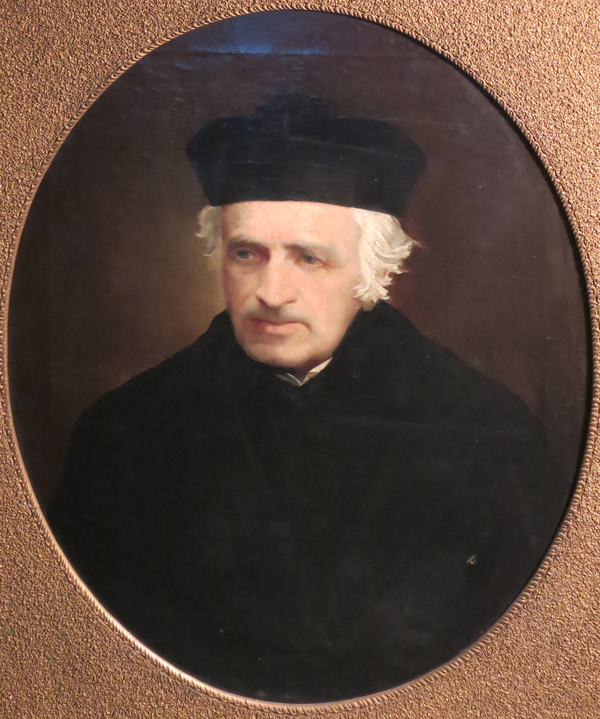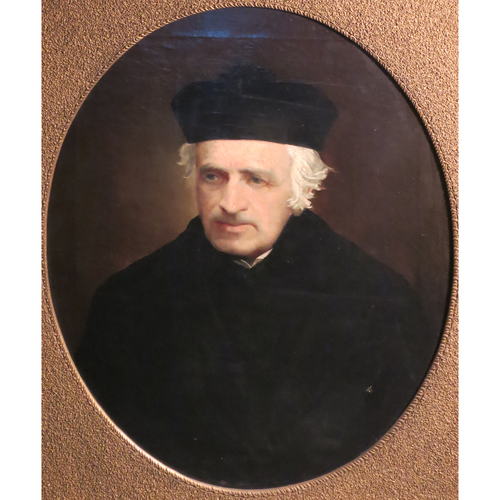
Source: Link
MARTIN, FÉLIX (baptized Félix-François-Marie), Jesuit priest, teacher, architect, and author; b. 4 Oct. 1804 at Auray, France, son of Jacques-Augustin Martin, a merchant, and Anne-Armèle Lauzer; d. 25 Nov. 1886 in Paris, France.
After studying under the Jesuits at the Petit Séminaire de Sainte-Anne in Auray, Félix Martin, inspired by his teachers and his elder brother Arthur, entered the noviciate at Montrouge, near Paris, in 1823; he transferred to the Noviciat Saint-Louis at Avignon in the following year. He studied philosophy at the Petit Séminaire de L’Arc at Dole in 1825 and the next year became a teacher at the Collège Saint-Acheul, in Amiens. When the 1830 revolution brought about the temporary dispersal of the Jesuit community in France, Martin was forced to take refuge at Brigue, Switzerland, where he finished his theological studies and was ordained priest in 1831. In the years from 1832 to 1839 he devoted himself particularly to teaching religion, mathematics, and drawing in Jesuit institutions and, when necessary, undertook parish and administrative duties. He spent this period in Spain, in France (at the residence in Vannes and the Collège Saint-Acheul), and then in Belgium (at the Collège de Brugelette). In 1839 he was in France, at Angers, where until 1842 he was engaged in preaching and in studying English.
On 31 May 1842 Martin arrived at Montreal with a group of Jesuits who had been invited by Bishop Ignace Bourget to re-establish the Society of Jesus in the Province of Canada [see Jean-Pierre Chazelle*]. He lived for a brief period at the bishop’s palace and then at La Prairie, Canada East, where he prepared a series of sermons and retreats; as a result, during the next six years he preached in several parishes and colleges in the Montreal region. In 1844 he was appointed superior of the Jesuits in Canada East, to replace Chazelle who was now directing the missions in Canada West [see Clément Boulanger*]. Armed with the pedagogical experience he had acquired in France, Martin founded the Collège Sainte-Marie at Montreal, himself assuming the duties of procurator, prefect of studies, and assistant master. The institution was temporarily set up in 1848 in confined quarters on Rue Saint-Alexandre and took in some 57 pupils during its first year. The Jesuits, who proposed to offer complete classical and commercial courses, had to have larger premises; Martin thus planned and began supervising the erection of a new edifice which housed the college from 1851. The first law school for French-speaking students in Canada East was inaugurated at the college that year, as a result of pressures exerted on Bourget and Martin by some influential Montreal lawyers [see François-Maximilien Bibaud]. Martin took advantage of his position as rector from 1851 to 1857 to introduce into the institution the programmes and traditions of the Collège Saint-Acheul and of the Collège de Brugelette. Hence discipline and the performance of religious duties were key features in the education given to the pupils.
During the 1820s Martin had been introduced to draughting and the fundamentals of architecture by his brother Arthur, a Jesuit who specialized in restoring Gothic churches in France. Soon after his arrival in Lower Canada, Martin drew up the plans for a number of religious buildings. Thus in 1843, with the help of architect Pierre-Louis Morin, he designed the front of St Patrick’s Church in Montreal. His name was also associated with the blueprints for the church of the Saint-François-Xavier mission at Caughnawaga; this church, begun in 1845, was remarkable for its projecting bell tower. From 1847 Martin supervised the construction of the new Collège Sainte-Marie according to his plans. This building, partially completed in 1851, was described as “solid but naïve” in conception; it had a complex system of sectional areas which could be adapted to the needs of a day-school, a residence for the Jesuit fathers, a noviciate, and a public chapel. The central portion of the Jesuit noviciate in the village of Sault-au-Récollet (North Montreal) was also erected under his supervision and according to his plans in 1852. Throughout this period Félix Martin was often consulted about the building and interior decoration of churches. In all probability he assisted architect Victor Bourgeau in his work and he is thought also to have taught the architect’s son.
Martin took a special interest in the religious history of New France. As soon as he arrived in Canada he began collecting the scattered documents connected with the Jesuit missions in the former French colony. With this task in mind, in 1844 he established the archives of the Collège Sainte-Marie, where he deposited the manuscripts and unpublished correspondence of the Society of Jesus unearthed by his persistent research throughout the religious communities of Quebec City. This development led him to take a closer interest in the Relations des Jésuites; after translating in 1852 the Relation by François-Joseph Bressani* that had been published in Italian 200 years earlier, Martin promoted a plan for the re-issue of the Relations des Jésuites covering the period 1611 to 1672, a venture completed at Quebec in 1858 under the direction of Georges-Barthélemi Faribault*, Édouard-Gabriel Plante, Jean-Baptiste-Antoine Ferland*, and Charles-Honoré Laverdière*. His most significant contribution was, however, the preparation with Fortuné Demontézon, of Mission du Canada; relations inédites de la Nouvelle-France . . . , which was brought out in two volumes in Paris in 1861. With an introduction and appendix drafted by Martin, this work included a collection of Relations for 1672 to 1679 which had not previously been published.
Recognized for his skill as a researcher, Martin received financial assistance from the government of the Province of Canada to carry out various projects. Thus in 1856 he was given the task of uncovering the traces of the old settlements of the Huron nation at Penetanguishene, Canada West, and he left an interesting manuscript on this subject. The following year he was commissioned to hunt through the archives kept in Paris and Rome for documents relating to Canadian history. On his return in 1858 he became a founding member of the Société Historique de Montréal. The next year was the centenary of the death of Louis-Joseph de Montcalm* and Martin embarked on a large-scale biographical study of him; it was not until 1867, however, that Le Marquis de Montcalm et les dernières années de la colonie française au Canada (1756–1760) appeared in Paris. His liking for biography prompted him subsequently to write a number of books about the principal martyrs of New France, published in various editions and translations.
Martin became superior of the Jesuits’ residence at Quebec in 1859 but had to return to France two years later to get treatment for his eyes. In 1862, after a brief stay at the École Sainte-Geneviève in Paris as spiritual director, he became rector of the Collège Saint-François-Xavier, in the town of Vannes. He was transferred to the residence at Poitiers in 1865 and there he served as superior, at the same time continuing his work on the history of New France, as his correspondence and the visit of historian Abbé Henri-Raymond Casgrain* in the following year attest. From 1868 he stayed at the Collège de l’Immaculée-Conception in Paris, where he took charge of the library and later served as superior. A witness of the Prussian occupation in 1870 and the Paris Commune in 1871, he kept a private diary of his impressions of these events. In consequence of the 1880 decree ordering the dissolution of the teaching congregations in France, Martin retired with a group of Jesuits to a residence in Paris where he died six years later. He had never found a way of carrying out his plan to return to Canada.
[As one of the scholars who undertook to reassess the historical role of the Canadian church, Félix Martin tried, through a great deal of research, to bring together the major documents relating to the Jesuit missions in New France. In this connection he was associated with the following publications: Relation des jésuites sur les découvertes et les autres événements arrivés en Canada, au nord et à l’ouest des États-Unis (1611–1672) . . . , E. B. O’Callaghan, édit., Félix Martin, trad. (Montréal, 1850); [F. J. Bressani], Relation abrégée de quelques missions des pères de la Compagnie de Jésus dans la Nouvelle-France . . . , Félix Martin, trad. (Montréal, 1852); Claude Dablon, Relation de ce qui s’est passé de plus remarquable aux missions des pères de la Compagnie de Jésus en la Nouvelle-France les années 1673 à 1679 . . . , Félix Martin et J. G. Shea, édit. (Montréal et New York, 1860); and Mission du Canada; relations inédites de la Nouvelle-France (1672-[1679]) pour faire suite aux anciennes relations (1615–1672) . . . , Fortuné Demontézon et Félix Martin, édit. (2v., Paris, 1861).
Martin also wrote a number of historical works of which the most important are: Le Marquis de Montcalm et les dernières années de la colonie française au Canada (1756–1760) (Paris, 1867); Le R. P. Isaac Jogues, de la Compagnie de Jésus, premier apôtre des Iroquois (Paris, 1873); Hurons et Iroquois; le P. Jean de Brébeuf, sa vie, ses travaux, son martyre (Paris, 1877). To locate the articles by Martin on archæology and on the study of the Huron Indians see: L’Album littéraire et musical et la rev. canadienne (Montréal), 1848. His religious publications are listed in Augustin de Backer et al., Bibliothèque de la Compagnie de Jésus, Carlos Sommervogel, édit. (3e éd., 9v., Bruxelles et Paris, 1890–1900). g.-é. g.]
Arch. de la Compagnie de Jésus, prov. du Canada français (Saint-Jérôme, Qué.), Fonds général, 1632–61. IBC, Centre de documentation, Fonds Morisset, 2, M379/F376. Firmin Vignon, Le P. Martin ([Montréal, 1886]). DOLQ, I: 170, 637–49. Paul Desjardins, Le collège Sainte-Marie de Montréal (2v., Montréal, 1940–[44]), I: 177–276. Les établissements des jésuites en France depuis quatre siècles . . . , Pierre Delattre, édit. (5v., Enghien et Wetteren, Belgique, 1949–57). Guy Frégault, “La recherche historique au temps de Garneau (la correspondance Viger-Faribault),” Centenaire de l’Histoire du Canada de François-Xavier Garneau . . . , [J.-J. Lefebvre, édit.] (Montréal, 1945), 371–90. Serge Gagnon, Le Québec et ses historiens de 1840 à 1920: la Nouvelle-France de Garneau à Groulx (Québec, 1978). G.-É. Giguère, “La restauration de la Compagnie de Jésus au Canada, 1839–1857” (2v. of manuscripts in the author’s possession; copies are available at various Jesuit archival repositories, libraries, and houses). J.-C. Marsan, Montréal en évolution: historique du développement de l’architecture et de l’environnement montréalais (Montréal, 1974). Luc Noppen, Les églises du Québec (1600–1850) (s.l., 1977). Léon Pouliot, Étude sur les relations des jésuites de la Nouvelle-France (1632–1673) (Montréal et Paris, 1940).
Cite This Article
Georges-Émile Giguère, “MARTIN, FÉLIX (baptized Félix-François-Marie),” in Dictionary of Canadian Biography, vol. 11, University of Toronto/Université Laval, 2003–, accessed January 8, 2026, https://www.biographi.ca/en/bio/martin_felix_11E.html.
The citation above shows the format for footnotes and endnotes according to the Chicago manual of style (16th edition). Information to be used in other citation formats:
| Permalink: | https://www.biographi.ca/en/bio/martin_felix_11E.html |
| Author of Article: | Georges-Émile Giguère |
| Title of Article: | MARTIN, FÉLIX (baptized Félix-François-Marie) |
| Publication Name: | Dictionary of Canadian Biography, vol. 11 |
| Publisher: | University of Toronto/Université Laval |
| Year of publication: | 1982 |
| Year of revision: | 1982 |
| Access Date: | January 8, 2026 |



